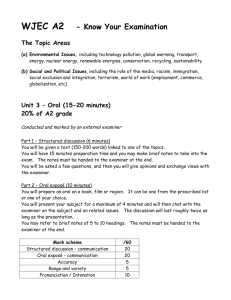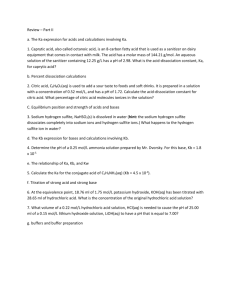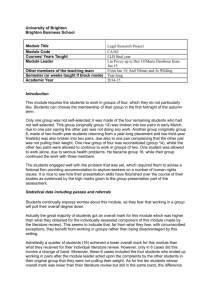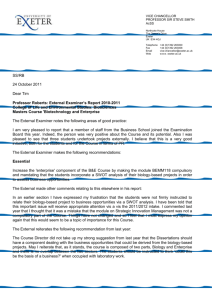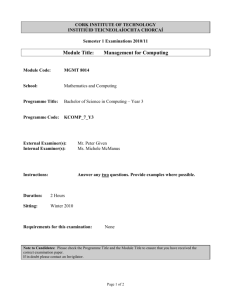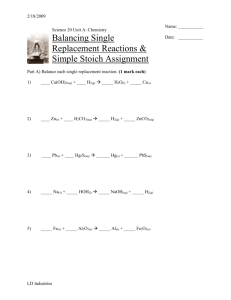A2 1, Periodic Trends and Further Organic, Physical and Inorganic
advertisement
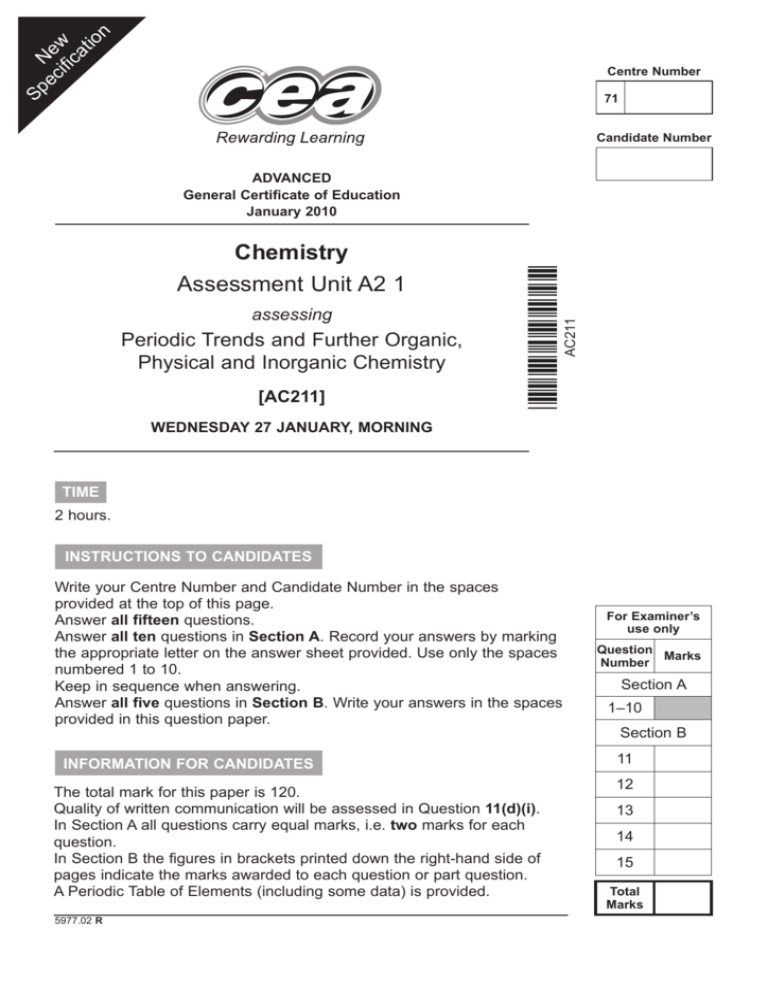
Sp N ec e ifi w ca tio n Centre Number 71 Candidate Number ADVANCED General Certificate of Education January 2010 assessing Periodic Trends and Further Organic, Physical and Inorganic Chemistry [AC211] AC211 Assessment Unit A2 1 *AC211* Chemistry WEDNESDAY 27 JANUARY, MORNING TIME 2 hours. INSTRUCTIONS TO CANDIDATES Write your Centre Number and Candidate Number in the spaces provided at the top of this page. Answer all fifteen questions. Answer all ten questions in Section A. Record your answers by marking the appropriate letter on the answer sheet provided. Use only the spaces numbered 1 to 10. Keep in sequence when answering. Answer all five questions in Section B. Write your answers in the spaces provided in this question paper. INFORMATION FOR CANDIDATES The total mark for this paper is 120. Quality of written communication will be assessed in Question 11(d)(i). In Section A all questions carry equal marks, i.e. two marks for each question. In Section B the figures in brackets printed down the right-hand side of pages indicate the marks awarded to each question or part question. A Periodic Table of Elements (including some data) is provided. 5977.02 R For Examiner’s use only Question Marks Number Section A 1–10 Section B 11 12 13 14 15 Total Marks Section A For each of the following questions only one of the lettered responses (A–D) is correct. Select the correct response in each case and mark its code letter by connecting the dots as illustrated on the answer sheet. 1 Which one of the following substances, when added to water in equimolar amounts, will form the solution with the highest pH? A B C D 2 Which one of the following substances has a different molecular formula from its empirical formula? A B C D 3 ammonium chloride ammonium ethanoate potassium ethanoate potassium chloride butanoic acid ethanal propanal propanone Zinc is manufactured by the reduction of its oxide using carbon. ZnO(s) + C(s) → Zn(s) + CO(g) ∆H = +237 kJ mol–1 ∆S = +190 J K–1 mol–1 What is the minimum temperature needed for this reaction to become feasible? A 154 K B 427 K C 975 K D 1248 K 4 How many isomers which have the molecular formula C3H6O can be reduced by lithal to an alcohol? A 1 B 2 C 3 D 4 5977.02 R 2 [Turn over 5 Which one of the following compounds contains co-ordinate (dative) bonds? A B C D 6 Al2Cl6 CCl4 MgCl2 NaCl The “bromine clock” reaction proceeds according to the equation: 6H+(aq) 5Br–(aq) + + BrO3–(aq) → 3Br2(aq) + 3H2O(l) The rate equation is: Rate = k[H+]2[Br– ][BrO–3 ] When the rate of disappearance of bromide ions is 1.2 × 10–4 mol dm–3 s–1, which one of the following statements is correct? A B C D 7 The The The The rate rate rate rate of of of of disappearance disappearance disappearance disappearance of of of of bromate(V) ions, BrO3–, is 1.2 × 10–4 mol dm–3 s–1. bromate(V) ions, BrO3–, is 2.4 × 10–5 mol dm–3 s–1. hydrogen ions is 1.4 × 10–8 mol dm–3 s–1. hydrogen ions is 1.0 × 10–4 mol dm–3 s–1 In which one of the following do all three oxides behave as indicated at room temperature? 5977.02 R neutralises dilute acid neutralises dilute alkali dissolves in water to form an acidic solution A Na2O MgO SiO2 B MgO Al2O3 Cl2O7 C P4O10 SiO2 SO3 D Al2O3 SO2 Na2O 3 [Turn over 8 The diagram shows the distribution of a substance X between ether and water at equilibrium. 10 cm3 of ether containing 3.28 g of X 75 cm3 of water containing 0.83 g of X [X in ether] What is the value of the partition coefficient Kd = [X in water] ? A B C D 9 3.95 7.50 29.64 32.80 Which one of the following would not be affected by boiling with aqueous sodium hydroxide? A B C D ethyl ethanoate glycerol olive oil propanoic acid 10 What is the pH of a solution containing 6.0 g of ethanoic acid, CH3COOH (Ka = 1.74 × 10–5 moldm–3), and 2.0 g of sodium ethanoate, CH3COONa, dissolved in 100 cm3 of solution? A B C D 5977.02 R 2.38 4.15 4.28 4.76 4 [Turn over Section B Examiner Only Marks Remark Answer all five questions in the spaces provided. 11 Formaldehyde (methanal), HCHO, is a colourless gas which is readily soluble in water. The aqueous solution is used for preserving anatomical specimens. (a) Explain why formaldehyde is soluble in water. [2] (b) Formaldehyde is a reducing agent as illustrated by its reaction with Tollen’s reagent. (i) Write an equation for the oxidation of formaldehyde using [O] to represent the oxidising agent. [1] (ii) Write the half-equation for the reduction of silver ions in Tollen’s reagent. [1] (iii) What is observed during this reaction? [1] (c) Formaldehyde reacts with hydrogen cyanide. Draw a flow scheme for the mechanism of this reaction. [3] 5977.02 R 5 [Turn over (d) Methanoic acid undergoes an acid catalysed reaction with bromine according to the equation: Br2(aq) + HCOOH(aq) H+(aq) Examiner Only Marks Remark 2Br -(aq) + 2H+(aq) + CO2(g) (i) Suggest an experimental method to investigate the rate of this reaction. How would you find the order of the reaction with respect to bromine? [4] Quality of written communication [2] (ii) The rate law was found to be Rate = k[Br2][HCOOH] Deduce the units for the rate constant k. [1] (iii) On the axes below, sketch the expected shape of the graphs in this reaction. rate [HCOOH] time [HCOOH] [2] 5977.02 R 6 [Turn over (e) Methanoic acid reacts with ethanol in the presence of concentrated sulphuric acid to form an ester. Examiner Only Marks Remark (i) Write the equation for this esterification. [2] (ii) Name the ester formed. [1] (iii) State two functions of concentrated sulphuric acid in this reaction. [2] 5977.02 R 7 [Turn over 12 The combustion of non-renewable hydrocarbon fuels has contributed to the increase in the atmospheric concentration of carbon dioxide. This in turn is believed to be a key factor in global warming. Examiner Only Marks Remark (a) Carbon dioxide absorbs infra-red radiation. State two effects this radiation has on the bonds in a carbon dioxide molecule. [2] (b) Photosynthesis involves conversion of carbon dioxide and water into a carbohydrate and oxygen. (i) Write an equation for photosynthesis representing the carbohydrate as C6H12O6. [1] (ii) A mature tree can produce approximately 220 kg of oxygen per year. What volume of carbon dioxide, measured at one atmosphere pressure and 20 ºC, does a tree need to produce this mass of oxygen? [3] (iii) Wood is approximately 50% cellulose. Burning wood releases carbon dioxide into the atmosphere. Write an equation for the complete combustion of cellulose. Use the formula C6H10O5 to represent cellulose. [2] (c) The oceans play an important part in determining the percentage of carbon dioxide in the atmosphere. It is estimated that the oceans contain some 3.9 × 1013 tonnes of carbon in total. Calculate the mass of carbon dioxide which the oceans have absorbed to contain this mass of carbon. [2] 5977.02 R 8 [Turn over (d) Carbon dioxide dissolves in water according to the equation: Examiner Only Marks CO2(g) + aq CO2(aq) Remark Equilibrium 1 Approximately 4% of the dissolved carbon dioxide reacts with water to form hydrogencarbonate ions and hydrogen ions in a further equilibrium. CO2(aq) + H2O(l) HCO3–(aq) + H+(aq) Equilibrium 2 (i) Explain the effect a rise in atmospheric carbon dioxide levels would have on the position of Equilibrium 1. [1] (ii) Write an expression for the equilibrium constant, Kc, for Equilibrium 2. [1] (iii) A solution of carbon dioxide is weakly acidic. Explain whether the value of Kc will be large or small. [1] 5977.02 R 9 [Turn over 13 Ketones and carboxylic acids are produced by the oxidation of alcohols. Examiner Only Marks Remark (a) The identity of an unknown ketone was determined by preparing the solid derivative from 2,4-dinitrophenylhydrazine and determining the melting point of the purified product. (i) Write the equation for the reaction of butanone with 2,4-dinitrophenylhydrazine. [3] (ii) State the expected colour of the solid derivative. [1] (iii) Describe how you would purify the solid derivative. [3] (iv) Describe how the melting point of the purified solid would be determined experimentally. [3] (v) What two effects would impurities have on the recorded melting point? [2] 5977.02 R 10 [Turn over (b) Lactic acid, CH3CHOHCOOH, is a weak acid which builds up in muscles during exercise. The molecule is optically active. Examiner Only Marks Remark (i) Explain the term optically active. [2] (ii) Draw the 3D structures of the two chiral isomers. [2] (c) In an experiment to determine the percentage by mass of lactic acid in an aqueous solution, 25.0 cm3 samples of the acid solution were titrated against 1 mol dm–3 sodium hydroxide solution. The average titre was found to be 24.3 cm3. (i) Write the equation for the reaction of lactic acid with sodium hydroxide. [1] (ii) Calculate the molarity of the lactic acid solution. [3] (iii) Calculate the concentration of the lactic acid solution in g dm–3. [2] (iv) Name a suitable indicator for this titration. [1] 5977.02 R 11 [Turn over (d) A carboxylic acid was found to contain 58.7% carbon, 9.8% hydrogen and 31.5% oxygen. Deduce the empirical formula of the acid. Examiner Only Marks Remark [3] (e) Fats and oils are triesters of glycerol and long chain carboxylic acids. The fat contained in mutton is predominantly a triester formed from stearic acid, CH3(CH2)16COOH. (i) Draw the structure of this triester. [2] (ii) The saponification value of a fat provides information about the structure. Define the term saponification value and explain what a high value would indicate about a fat. [4] 5977.02 R 12 [Turn over 14 Citric acid is a weak tribasic acid found in citrus fruits. It has the following structure: CH2 HO C CH2 Examiner Only Marks Remark COOH COOH COOH (a) (i) How many asymmetric (chiral) centres are present in the molecule? [1] (ii) The partially completed systematic name for citric acid is given below. Complete the name by inserting commas and hyphens in the appropriate spaces. 2 hydroxypropane 1 2 3 tricarboxylic acid [2] (b) Citric acid reacts with sodium hydrogencarbonate in an endothermic reaction. The expression ∆G = ∆H – T ∆S can be used to explain why endothermic processes can proceed spontaneously. (i) Write the equation for the reaction of citric acid with excess sodium hydrogencarbonate. [2] (ii) State one observation which would indicate the reaction was complete. [1] (iii) Explain the meaning of the symbol ∆S . [2] 5977.02 R 13 [Turn over (iv) Explain, in terms of the expression ∆G = ∆H – T ∆S , why the reaction of citric acid with sodium hydrogencarbonate proceeds spontaneously despite being endothermic. Examiner Only Marks Remark [2] (c) The first acid dissociation constant, Ka, for citric acid is 8.4 × 10–4 mol dm–3. (i) Write an equation for the first ionisation of citric acid in aqueous solution. [1] (ii) Write an expression for the first acid dissociation constant, Ka, for citric acid using RCOOH to represent citric acid. [1] (iii) Calculate the pH of a 0.1 mol dm–3 solution of citric acid assuming only the first ionisation takes place. [3] 5977.02 R 14 [Turn over 15 Compounds containing fluorine find diverse uses including polymer manufacture and additives for toothpaste. Examiner Only Marks Remark (a) The polymer Teflon, polytetrafluoroethene, is made by polymerising tetrafluoroethene which itself is produced from chlorodifluoromethane according to the equation: 2CHClF2(g) C2F4(g) + 2HCl(g) ∆H = +128 kJ mol–1 (i) State and explain the effect of increasing the overall pressure on the yield of tetrafluoroethene. [2] (ii) State and explain the effect of increasing the temperature on the yield of tetrafluoroethene. [2] (iii) 0.2 mole of chlorodifluoromethane was placed in a 5 dm3 sealed flask and heated. At equilibrium the mixture obtained contained only 0.04 mole of the gas. Calculate the value of Kc for this reaction and state its units. [4] (iv) State two advantages of polymer disposal by incineration compared to landfill. [2] 5977.02 R 15 [Turn over (b) Sodium fluoride is added to toothpaste to reduce tooth decay. The partially completed Born-Haber cycle for sodium fluoride is shown below. Examiner Only Marks Remark Na+(g) + F–(g) NaF(s) (i) Complete the empty boxes above by inserting the appropriate chemical symbols. [4] (ii) Using the data below, calculate the lattice enthalpy for sodium fluoride. First ionisation energy of sodium Enthalpy of atomisation of sodium Bond enthalpy of fluorine Electron affinity of fluorine Enthalpy of formation of sodium fluoride kJ mol–1 +496 +107 +158 –333 –574 [2] (iii) Write the electronic configuration in s, p and d notation for a sodium ion, Na+, and a fluoride ion, F–. sodium ion fluoride ion 5977.02 R [2] 16 [Turn over THIS IS THE END OF THE QUESTION PAPER 5977.02 R 17 [Turn over Permission to reproduce all copyright material has been applied for. In some cases, efforts to contact copyright holders may have been unsuccessful and CCEA will be happy to rectify any omissions of acknowledgement in future if notified. 5977.02 R
